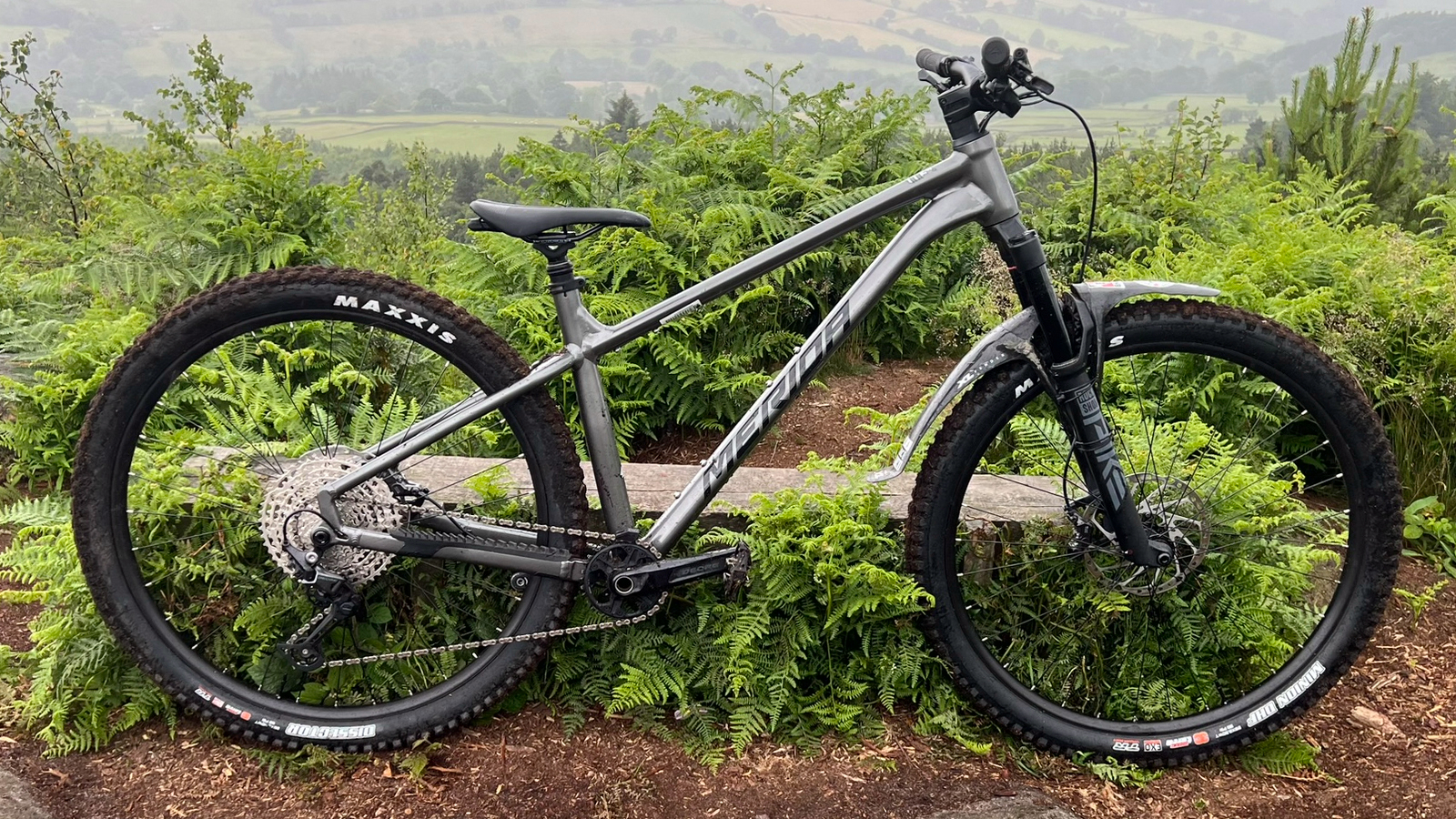
Two of the biggest mountain bike brands in the world – Specialized and Merida – launched new bikes this week. But while the radicalized Big Trail seems to have gone down really well, it’s fair to say that Specialized’s new Stumpjumper has definitely provoked mixed reactions in comments. In contrast, another bike launch by a company known for cameras and drones has totally dominated news coverage. Meanwhile, there are other launches incoming next week, one of which is being massively underplayed considering the size of the brand and the importance of this particular bike in their range.
So what are the challenges with trying to launch a new bike right now, how are designers, brand managers and marketing teams handling that, and how do I do my job as a reporter?
The bargain bin backdrop
The biggest issue with launching a bike now is that there are still a lot (we’re talking thousands for many brands and rumoured million plus for some) of previous generation bikes waiting in warehouses despite websites and shops trying to clear them with discounts of up to 50 percent off. If you’re really unlucky – like Specialized with their Stumpjumper Evo and the Epic Evo – those bikes are already some of the best you can buy. If you look closely, the bikes being offered at 30 to 40 percent off are often only available in very limited size and color options. However, the headline price comparisons between a carbon bike with premium kit like an Epic Evo and an alloy frame with budget bits like the Chisel FS are easy to make in comments sections or anywhere else you want to be an online smart arse.

Cutting back to move forward
You can pick any number of reasons why there are so many unsold bikes sitting gathering dust and debt. Bat flu, Ukrainian war, African pirates, not enough shipping containers are all in the mix for sure. But mainly it’s the whiplash sting of over-ordering to match the ridiculous panic buying triggered by lockdown’s one night stand with cycling being mistaken for a lasting relationship. And while we can all tut about the industry being greedy, anyone who asked their local bike shop for something and then ordered one online is as much to blame as anyone else in the chain.
That means savvy companies are drastically trying to slim down their bike ranges as much as possible. Trek announced they were culling their bike range by 40 percent in March and the launch of the Stumpjumper 15 this week saw Specialized reducing the frames needed to cover the XC to trail range by 50 percent. That’s because the new Stumpjumper is designed to cover the riding range of the previous Stumpjumper and the Stumpjumper Evo with just one frame and a new highly adjustable ‘Genie’ shock. This follows the same range consolidating approach that saw them building the Epic 8 race bike and Epic 8 Evo downcountry bike from the same base frameset, rather than using totally separate designs. That means Specialized has gone from four different molds in a full range of sizes to cover the Epic and Stumpjumper family to just two. And frankly, that’s genius, not least because nobody really saw that as an issue on the Epic 8, mainly because the Epic 8 replaced the super popular Epic 7 Evo and the Epic 8 Evo was a natural progression towards radder riding.
The issue Spesh has been hit with Stumpjumper 15 is that Stumpjumper Evo was a huge success for them with a whole shelf of ‘bike of the year’ and ‘best in test’ awards. Not only is that a hard bike to follow, especially when you also need to overlap with a shorter travel bike, but it also has a very passionate – and it turns out – vocal ownership. Those folks have lost no time in saying how the shorter fork, ‘proprietary shock’, and lack of wired gearing provision means a ‘hard no’ from them in terms of considering upgrading to the Stumpjumper at some point.

New stuff is risky
That’s because the thing you always need to remember about many humans is that a lot of our baseline neural wiring is still a primal, simian survival setup. That means whether it’s a spotty cat with pointy teeth a few million years ago, or the comment section under a YouTube video yesterday, a common reaction when presented with new things is to distrust and potentially attack it.
Considering how frustrating that can feel just from the point of view of reporting on it, I can only imagine how much eye-rolling it causes engineers and brand managers. Actually, I don’t need to imagine it, I know enough of them well enough to be a useful ‘vent’ ear to know exactly how exasperating having the new thing you slaved over and have actual science to prove is better, being damned by an armchair ‘engineer’ and his online disciples who clearly doesn’t understand how it works and definitely hasn’t ridden it. In fact, the most recent comment I got on my Tech Talk video of the Stumpjumper 15 was someone saying how the version of SWAT they have on their Evo was better than the new one. OK, so you like yours and you’ve had no problem with water getting in even when jet washing. But the new one is lighter because it fits directly into the frame, and is not a frame within a frame. The catch is smoother and more repairable. It’s flush fit and has a better seal. It’s quantifiably, measurably better in several ways
Want another example? Another journalist sent me an Instagram post with a cartoon clearly about the Genie shock with the caption “I think I’ll try to make a more reasoned post about a recent bike launch, but for now here’s a meme…..” And yeah it was funny, and made a very fair point. A whole new shock is a risky move, even if it’s largely based around common parts and can easily be replaced with a conventional shock if necessary plus Specialized – like Trek and nearly every other brand who’s gone that route – have had some nightmares with proprietary shocks in the past. But where would mountain bikes be if we hadn’t moved on from touring bike gears and motorbike brake levers running cyclo cross brakes which is what the original Stumpjumper had 43 years ago?
While people have been roasting the Genie’s lamp pretty hard rather than rubbing it, that’s nothing to the ‘kill it with fire’ reaction that the wireless-only design language of the new Stumpjumper has been greeted with. TBH, I thought it was a really neat idea that makes the bike look a lot tidier without having to resort to the dreaded headset-routed cable solution. They’ve also gone to the trouble of asking for a more affordable S-1000 AXS T-Type group for their Comp models so I hadn’t even flagged it up as a negative on my first review draft. But then maybe that’s a reflection that I’m getting as out of touch as design teams who don’t have to pay for their parts and effectively have AXS on draught. Either way, you’re going to have to get used to frames that only work with radio-controlled ratios as I know there are at least a couple more high-profile bikes coming soon that’ll only have piping for a dropper post and rear brake hose. Or to put it another way, when I asked their distributor if he’d seen how much heat the Stumpy was getting, they replied “Yeah, about that….”

Trail bikes are topped out
One of the major reasons brands are moving towards what are essentially ‘sideshow’ changes on bikes is because all the major performance points in terms of geometry and suspension are pretty much plateau'd now. I can’t think of any major brands where their current bikes aren’t very well sorted in terms of how they ride for their intended category. Most of them have already added some sort of internal storage hatch, or at least some sort of nod towards extra storage. UDH hangers are genuinely universal now too.
Moving towards modern geometry isn’t a guaranteed win either, as I found out when I slagged off Pinarello’s Dogma XC bike and Mondraker’s Chrono Carbon downcountry bike only to be told by many people that what I’d branded throwback handling sounded ideal to them. That means I’m genuinely interested to see if Merida combining ‘daily driver’ utility features like rack and kickstand mounts with a 64-degree head angle on their latest Big Trail bike is a Big Win or a Big Fail.

Launch or leak?
All of which makes it less surprising that one of the other big brands announced the relaunch of one of their biggest selling bikes with the following email. “We are stoked to launch new *********** next week. We decided not to ask you to sit through a recorded presentation this year. You will find everything you need in the media kit:” Unless they’re lying or I’ve missed out on the launch rides, the brand doesn't even have media bikes available yet either, so for once I won’t be dropping a review on here or swamping online media with my usual blend of shouting about angles while dodging trees. For context, this is from a brand that used to fly journalists and dealers all round the world to ride camps so large they made the D–Day invasion look like a village fair. And having looked at that media kit, they’ve not made many changes to their bike either. There’s certainly no proprietary shock in play and the build kits feature both SRAM and Shimano options, so I’m guessing there’s some holes in the frames to put wires through.
Or were Specialized right to fly a crew of us out to Vancouver Island for just two days of riding? Was it a combination of jet lag, incredible trails, and the surprise double whammy of both Specialized founder Mike Sinyard and Santa Cruz bikes founder Rob Roskopp sharing trails and branded merch that shocked me into overlooking their outrageous analog abandonment? Or maybe, just maybe, the bike really is very, very good and people should perhaps reserve judgment until they’ve actually ridden it themselves. But then, we live in a media world where nothing creates more traction than hate and anger and the old adage that there’s no such thing as bad publicity has never rung truer.
And on that note, I guess we’ll just have to see how the world reacts to next week’s more low-key leak than actual launch and try to work out whether that’s a better way to bring out a bike these days than the full-on 50th birthday party that Specialized threw.







